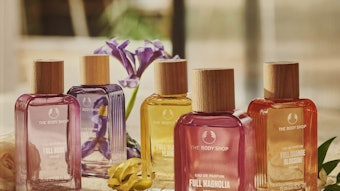Sample-sized, single doses or wipes are a current cosmetic market trend. Beauty products must be discreet yet effective, practical and even fun. Discreet is also a requirement of the new Transport European Directive that, by limiting the presence of liquids or pasty substances on an aircraft, reinforces the current evolution towards the search for new textures.
Cream in powder form is a loose powder trapping high content of liquid, developed by LCW Laboratories. The resulting product offers interesting properties and an outstanding sensory texture upon application.
Powders, creams and cream-to-powders have been well-known in the industry. However, a cream in powder form has been formulated to create surprising texture. The principle of this innovation is based on the development of a powder which is turned into a cream. Indeed, it is a loose powder containing a high proportion of a liquid phase. Upon application, the fine powder disappears under soft massage on the skin and is transformed into a cream or oily gel. The specific ingredients chosen can provide innovative results—treated pigments are combined with cosmetic powders and a liquid phase to create this newer formulating concept.
Key Ingredients
This cream in powder concept is mainly based on a specific combination of two families of ingredients: treated pigments and thickeners.
Treated pigments: The coatings of pigments and cosmetic fillers by suitable chemical substances modify their surface properties by imparting new performance properties such as good dispersibility, better adhesion on skin, water resistance, superior tactile effects. The surface treatments applied to traditional pigments or to more sophisticated powders are now essential to modify the textures and stability of formulas while improving their feel, application and wetting capabilities. In particular, silicone or silane surface treatments provide hydrophobic properties to powders, limiting their absorption capacity of liquid while giving an improved soft feeling. For this reason, the silane or silicone treated pigments are particularly used in the aqueous version of the cream in powder form. They have low affinity for the liquid phase and consequently, they contribute to maintain the physical form of loose powder avoiding the disastrous formation of a thick paste.
In addition, other treated pigments combine hydrophobic and lipophobic properties. They are coated with perfluoro substances, giving them good resistance to perspiration and sebum and better adhesion on the skin with long-lasting finish. They are not affected by the presence of oil in the oily version of the cream in powder form and as a result, they maintain the stability of the loose powder formulation.
Conventional pigments have been used in the past primarily to give color to a formulation; however, with modifications to their surface, they also can contribute to the creation of new sensory textures.
Thickeners: Thickeners have an essential function in this formulating concept in that they dictate the final formula texture by stabilizing the gel structure. Their selection depends on the nature of the liquid phase in which they are used—aqueous or oily phase. For example, sodium carboxymethyl starch is an the best thickener for success in an aqueous phase. It is a unique natural thickener and presents a fine, soft texture and instant gelling capacity.
Formulations
Aqueous phase: Formulating a cream in powder makeup in an aqueous version is based on the mixture of cosmetic powders selected for their texture, thickeners with unique performances, actives, surface treated pigments and an aqueous phase. This composition could contain up to 80% water. The finished product results from the mixture of all the powders with water in a blender and its stability is revealed by the formation of a loose powder and not a thick paste. The formula stability is dependent on the presence of cosmetic powders having low affinity for the aqueous phase, surface treated nanofine titanium dioxide and also hydrophobic pigments. Moreover, the use of treated pigments in the formulations imparts an excellent wear identical to the one of conventional cream.
This cream in powder form can be composed of a combination of actives in powder or liquid form, while also offering the opportunity to add perfume without affecting the effectiveness or stability.
This formulating concept can be adapted to skin care products but also to make-up lines. Their common characteristic is a completely remarkable fresh effect in the finished product.
The unabridged feature with references and charts is available through www.CosmeticsandToiletries.com.










